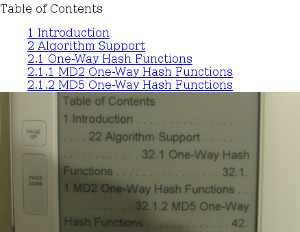Tuesday, January 26. 2010
Hanvon WISEreader N526 - hardware fine, software a desaster
 When asking me what I'd consider the most interesting technical developments in the near future, electronic books would be on the top of my list. So recently, I finally decided to buy one and ordered a Hanvon WISEreader N526. It has a pretty fair price, it seemed that free software support was likely to appear some time in the future (more on that later) and it has a touchscreen with pen, which was a feature I wanted to mark things in books.
When asking me what I'd consider the most interesting technical developments in the near future, electronic books would be on the top of my list. So recently, I finally decided to buy one and ordered a Hanvon WISEreader N526. It has a pretty fair price, it seemed that free software support was likely to appear some time in the future (more on that later) and it has a touchscreen with pen, which was a feature I wanted to mark things in books.From the hardware side, the device is pretty ok. Most ebook readers on the market share the same technologie for the display, it could have a bit more contrast, but else it's pretty okay. The device itself has a keyboard (which is querty, but not really ordered like a querty-keyboard), USB (not working as mass storage though), an audio output and a micro SD slot. Also, as said above, it has a touchscreen that can be used with a pen. So on the hardware side the device is quite fine.
What's not fine is the software running on it. It makes many features pretty much useless. Just to name a few flaws:
- Adding marks with the pen, one of the main features of the hardware, is pretty useless. It works neither on PDFs nor on epub files. It only works for TXT and HTML files, so it's not possible to do any marks on any layouted file format.
- HTML files are not supported. The vendor claims HTML support, but that's a plain lie. What it does is stripping out all HTML tags and showing the Text. If you know how HTML works, you can expect that this leads to pretty broken results and breaks all layout in HTML. Also, Hyperlinks don't work at all.
- The zooming capabilities are very limited. For text, you only have three zoom levels. All of them are far larger than normal text in a book. For PDF, it's possible to make it fit on height or width, but not anything in between.
- If you browse the files, there is no possibility to show the full filename, it only shows the beginning of the filename (about 20 characters). If you have files named “Author's name – Book title“ (which seems like a pretty common idea), you will only see some files with the author's name – not very useful.
- The device has a button for landscape view (turn the view 90°). But it doesn't work. Probably a bug.

Example for HTML “support“ compared with original
Another thing I'm looking at is OpenInkpot. It's a free firmware for ebook devices and they are working on support for the N526. However, having talked to the developers it seems that support for the touchscreen/pen is pretty unsure, as the vendor refuses to provide any documentation for that. Also, as this is a volunteers project, it's not clear if and when proper support will be available.
Tuesday, January 19. 2010
Zählpixel für die VG Wort
Die VG Wort ist eine Verwertungsgesellschaft für Texte. In Deutschland gibt es Zwangsabgaben für die Hersteller diverser Geräte (Kopierer, Scanner, Drucker, PCs, CD-Brenner etc.), die zur Verfielfältigung urheberrechtlich geschützter Werke geeignet sind. Diese werden von Verwertungsgesellschaften (die bekannteste ist wohl die GEMA) an Urheber von Texten, Bildern, Musik etc. ausgeschüttet. Das ist nicht gänzlich unumstritten, aber viele sind der Ansicht, dass dies eine probate Alternative zu immer strikteren Urheberrechten darstellt. Es führt etwa dazu, dass zumindest in gewissem Rahmen Privatkopien legal möglich sind. Allerdings gibt es zwischen der GEMA und der VG Wort einen wichtigen Unterschied. Will man bei der GEMA mitmachen, muss man sich deren Regeln unterwerfen. So ist es etwa nicht möglich, als GEMA-Mitglied Musik unter Creative Commons-Lizenzen zu veröffentlichen. Die VG Wort macht einem Autor keine derartigen Vorschriften.
Für Internet-Texte gibt es von der VG Wort das System METIS (MEldesystem für Texte auf InternetSeiten). Dabei kann man Texte auf Webseiten mit sogenannten Zählpixeln auszustatten. Das sind im Prinzip winzige, unsichtbare Bilder, die von einem Server der VG Wort heruntergeladen werden und in Beiträge eingebunden werden. Und hierbei kann man Bauchschmerzen haben - denn dabei werden natürlich Daten meiner Besucher an die VG Wort übertragen. Allerdings muss man dazusagen: Dieses Blog ist auch mit Google Ads ausgestattet - das führt ebenfalls dazu, dass eine externe Firma theoretisch Zugriff auf die Daten meiner Besucher hat. Unterbinden kann man beides mit gängigen Tools zum Blocken von Werbung, etwa Adblock Plus für Firefox.
Thursday, January 14. 2010
BIOS update by extracting HD image from ISO
Today I faced an interesting Linux problem that made me learn a couple of things I'd like to share. At first, we found an issue on a Thinkpad X301 notebook that was fixed in a newer BIOS version. So we wanted to do a BIOS update. Lenovo provides BIOS updates either for Windows or as bootable ISO CD-images. But the device had no CD-drive and only Linux installed. First we tried unetbootin, a tool to create bootable USB sticks out of ISO-Images. That didn't work.
So I had a deeper look at the ISO. What puzzled me was that when mounting it as a loopback device, there were no files on it. After some research I learned that there are different ways to create bootable CDs and one of them is the El Torito extension. It places an image of a harddisk on the CD, when booting, the image is loaded into memory and an OS can be executed (this probably only works for quite simple OSes like DOS, the Lenovo BIOS Upgrade disk is based on PC-DOS). There's a small PERL-script called geteltorito that is able to extract such images from ISO files.
It's possible to boot such harddisk images with grub and memdisk (part of syslinux). Install syslinux, place the file memdisk into /boot (found in /usr/lib/syslinux/ or /usr/share/syslinux/) and add something like this to your grub config:
Or for grub2:
Now you can select bios update in your boot menu and it should boot the BIOS upgrade utility.
(Note that this does not work for all Lenovo BIOS updates, only for those using an El Torito harddisk image - you can mount your iso with mount -o loop [path_to_iso] [mount_path] to check, if there are any files, this method is not for you)
So I had a deeper look at the ISO. What puzzled me was that when mounting it as a loopback device, there were no files on it. After some research I learned that there are different ways to create bootable CDs and one of them is the El Torito extension. It places an image of a harddisk on the CD, when booting, the image is loaded into memory and an OS can be executed (this probably only works for quite simple OSes like DOS, the Lenovo BIOS Upgrade disk is based on PC-DOS). There's a small PERL-script called geteltorito that is able to extract such images from ISO files.
It's possible to boot such harddisk images with grub and memdisk (part of syslinux). Install syslinux, place the file memdisk into /boot (found in /usr/lib/syslinux/ or /usr/share/syslinux/) and add something like this to your grub config:
title HD Image
root (hd0,0)
kernel /boot/memdisk
initrd /boot/image.img
root (hd0,0)
kernel /boot/memdisk
initrd /boot/image.img
Or for grub2:
menuentry "HD Image" {
set root=(hd0,2)
linux16 /boot/memdisk
initrd16 /boot/hdimage.img
}
set root=(hd0,2)
linux16 /boot/memdisk
initrd16 /boot/hdimage.img
}
Now you can select bios update in your boot menu and it should boot the BIOS upgrade utility.
(Note that this does not work for all Lenovo BIOS updates, only for those using an El Torito harddisk image - you can mount your iso with mount -o loop [path_to_iso] [mount_path] to check, if there are any files, this method is not for you)
Sunday, January 10. 2010
Vortragsfolien über Wachstum
Ich hatte auf dem JUKSS einen kurzen Einführungsvortrag zu Wirtschaftswachstum und Wachstumskritik gehalten. Hier gibt's die Folien dazu.
Bei der Gelegenheit noch zwei sehenswerte Videos zum Themenkomplex Wachstum und Peak Oil:
Bis zum letzten Tropfen - einführende Doku auf NDR über Peak Oil
Vortrag von Wolfgang Blendinger über Peak Oil (gehalten an der Uni Tübingen, Blendinger ist Deutschlands einziger Professor für Erdölgeologie und Mitglied der ASPO, einer Organisation von Wissenschaftlern, die sich mit dem Thema Peak Oil befassen)
Bei der Gelegenheit noch zwei sehenswerte Videos zum Themenkomplex Wachstum und Peak Oil:
Bis zum letzten Tropfen - einführende Doku auf NDR über Peak Oil
Vortrag von Wolfgang Blendinger über Peak Oil (gehalten an der Uni Tübingen, Blendinger ist Deutschlands einziger Professor für Erdölgeologie und Mitglied der ASPO, einer Organisation von Wissenschaftlern, die sich mit dem Thema Peak Oil befassen)
Posted by Hanno Böck
in Ecology, Politics
at
20:26
| Comments (0)
| Trackbacks (0)
Defined tags for this entry: grenzendeswachstums, jukss, ökologie, peakoil, umwelt, wachstum, wachstumskritik
Friday, January 8. 2010
Videos aus ARD Mediathek herunterladen
Ich stand heute vor dem Problem, ein Video aus der ARD-Mediathek herunterladen zu wollen. Die gibt es meistens nur noch als Flash und ohne Download-Link.
Die Videos werden über RTMP übertragen, was ein Flash-eigenes Videostreaming-Protokoll ist. Im gulli-Forum fand ich eine Anleitung. Ich habe darauf basierend ein kleines Skript ardget geschrieben, mit dem man das bequem erledigen kann. Aufzurufen einfach über
ardget "[URL der Mediathek]"
Die Anführungszeichen sind notwendig, weil die URLs &-Zeichen enthalten, die sonst von der Shell fehlinterpretiert werden. Da die Videos teilweise mit Javascript-URLs verlinkt sind, filtere ich das auch entsprechend, man kann also den kompletten javascript: beginnenden Link übergeben. Benötigt wird entweder flvstreamer oder rtmpdump, sollte ansonsten in jeder gängigen Unix-Shell funktionieren.
Die Videos werden über RTMP übertragen, was ein Flash-eigenes Videostreaming-Protokoll ist. Im gulli-Forum fand ich eine Anleitung. Ich habe darauf basierend ein kleines Skript ardget geschrieben, mit dem man das bequem erledigen kann. Aufzurufen einfach über
ardget "[URL der Mediathek]"
Die Anführungszeichen sind notwendig, weil die URLs &-Zeichen enthalten, die sonst von der Shell fehlinterpretiert werden. Da die Videos teilweise mit Javascript-URLs verlinkt sind, filtere ich das auch entsprechend, man kann also den kompletten javascript: beginnenden Link übergeben. Benötigt wird entweder flvstreamer oder rtmpdump, sollte ansonsten in jeder gängigen Unix-Shell funktionieren.
(Page 1 of 1, totaling 5 entries)